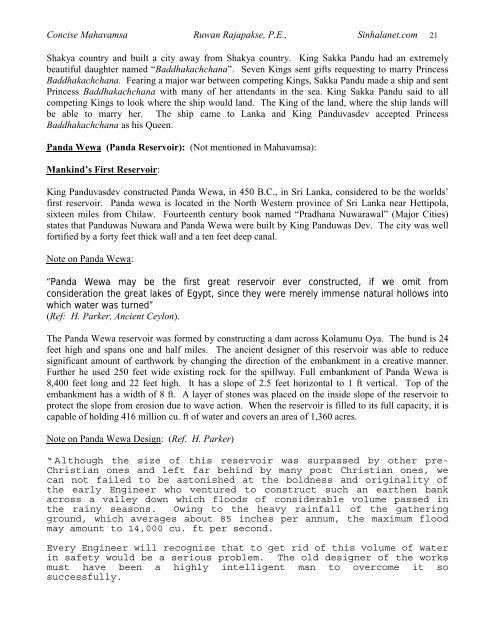Concise Mahavamsa Ruwan Rajapakse, P.E., Sinhalanet.com 1
Concise Mahavamsa Ruwan Rajapakse, P.E., Sinhalanet.com 1
Concise Mahavamsa Ruwan Rajapakse, P.E., Sinhalanet.com 1
Create successful ePaper yourself
Turn your PDF publications into a flip-book with our unique Google optimized e-Paper software.
<strong>Concise</strong> <strong>Mahavamsa</strong> <strong>Ruwan</strong> <strong>Rajapakse</strong>, P.E., <strong>Sinhalanet</strong>.<strong>com</strong> 21<br />
Shakya country and built a city away from Shakya country. King Sakka Pandu had an extremely<br />
beautiful daughter named “Baddhakachchana”. Seven Kings sent gifts requesting to marry Princess<br />
Baddhakachchana. Fearing a major war between <strong>com</strong>peting Kings, Sakka Pandu made a ship and sent<br />
Princess Baddhakachchana with many of her attendants in the sea. King Sakka Pandu said to all<br />
<strong>com</strong>peting Kings to look where the ship would land. The King of the land, where the ship lands will<br />
be able to marry her. The ship came to Lanka and King Panduvasdev accepted Princess<br />
Baddhakachchana as his Queen.<br />
Panda Wewa (Panda Reservoir): (Not mentioned in <strong>Mahavamsa</strong>):<br />
Mankind’s First Reservoir:<br />
King Panduvasdev constructed Panda Wewa, in 450 B.C., in Sri Lanka, considered to be the worlds’<br />
first reservoir. Panda wewa is located in the North Western province of Sri Lanka near Hettipola,<br />
sixteen miles from Chilaw. Fourteenth century book named “Pradhana Nuwarawal” (Major Cities)<br />
states that Panduwas Nuwara and Panda Wewa were built by King Panduwas Dev. The city was well<br />
fortified by a forty feet thick wall and a ten feet deep canal.<br />
Note on Panda Wewa:<br />
“Panda Wewa may be the first great reservoir ever constructed, if we omit from<br />
consideration the great lakes of Egypt, since they were merely immense natural hollows into<br />
which water was turned”<br />
(Ref: H. Parker, Ancient Ceylon).<br />
The Panda Wewa reservoir was formed by constructing a dam across Kolamunu Oya. The bund is 24<br />
feet high and spans one and half miles. The ancient designer of this reservoir was able to reduce<br />
significant amount of earthwork by changing the direction of the embankment in a creative manner.<br />
Further he used 250 feet wide existing rock for the spillway. Full embankment of Panda Wewa is<br />
8,400 feet long and 22 feet high. It has a slope of 2.5 feet horizontal to 1 ft vertical. Top of the<br />
embankment has a width of 8 ft. A layer of stones was placed on the inside slope of the reservoir to<br />
protect the slope from erosion due to wave action. When the reservoir is filled to its full capacity, it is<br />
capable of holding 416 million cu. ft of water and covers an area of 1,360 acres.<br />
Note on Panda Wewa Design: (Ref. H. Parker)<br />
“ Although the size of this reservoir was surpassed by other pre-<br />
Christian ones and left far behind by many post Christian ones, we<br />
can not failed to be astonished at the boldness and originality of<br />
the early Engineer who ventured to construct such an earthen bank<br />
across a valley down which floods of considerable volume passed in<br />
the rainy seasons. Owing to the heavy rainfall of the gathering<br />
ground, which averages about 85 inches per annum, the maximum flood<br />
may amount to 14,000 cu. ft per second.<br />
Every Engineer will recognize that to get rid of this volume of water<br />
in safety would be a serious problem. The old designer of the works<br />
must have been a highly intelligent man to over<strong>com</strong>e it so<br />
successfully.


